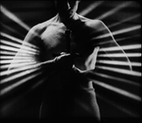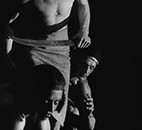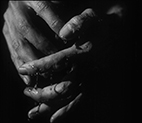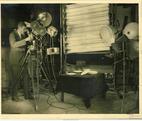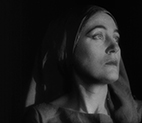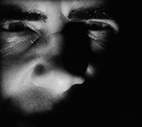Lot in Sodom - #2 - Censored 1.20 print - J.S. Watson, Jr.
- Unseen Cinema Collection |
- 1930-1933 |
- 27 minutes |
- B&W |
- SOUND
Rental Format(s): Digital File
Lot in Sodom (1930-32, released 1933)
Co-makers: J.S. Watson, Jr., Melville Webber, Alec Wilder, Remsen Wood, Bernard O'Brien
Original format: 35mm sound film 1.20:1 reformatted to 1.37:1
Direction: Melville Webber, Alec Wilder, Remsen Wood
Script: J.S. Watson, Jr., Melville Webber adapted from Genesis 19:8
Camera-printer effects: J.S. Watson, Jr.
Costumes-sets: Melville Webber
Sets-miniatures: Steve Kraskiewicz
Sound recording: Bernard O'Brien
Music: Louis Siegel
Musicians: Mitch Miller, Aileen Malone
Featuring Friederich Haak, Hildegarde Watson, Dorothea Haus, Lewis Whitbeck, Winslow Wilson, Remsen Woods, Alec Wilder, child of Neddy Royce
Courtesy Film Preservation Associates
The second most well-known collaborative experimental production helmed by the avant-gardist duo J.S. Watson, Jr. and Melville Webber produces an exemplary work of experimental cinema. Artfully illustrating Genesis 19:8, the filmmakers over-sex the screen with lusciously lit bodies and dynamic camera-printer effects. Approaching visual music, the hybrid of sound and image concludes with the fiery demise of Sodom. The biblical illusions are so well crafted that the explicit scenes avoided censor and continue to resonate a meaningful poetry for modern audiences. -Bruce Posner
In Lot, distortion is often used to keep reality, or rather its appearance, from disturbing the film's mood. And in the final scene distortion makes Lot's daughter seem not only different but formidable as she grasps the wine cup. -J.S. Watson, Jr. 1974
Technical note: The "uncensored" 1.37 version is 4 seconds longer than the "censored" 1.20 version that is missing several explicit shots and parts of shots near the beginning. The picture editing is nearly unnoticeable and seamless beyond the accompanying soundtrack that exhibits noticeable clicks at the excised parts. The cropped Academy 1.37:1 aspect ratio loses the top and bottom of the full and uncropped Movietone 1.20 aspect ratio. Differences in image quality are clearly apparent with the 1.37 image brighter with a wider tonal range, better contrasts, and sharper definition; and the 1.20 image less sharp, darker with a shorter tonal range, and showing more print use wear.
James Sibley [J.S.] Watson, Jr. (1894-1982) was regarded as a Renaissance man in each of his chosen fields: medical doctor and researcher, man of letters, preservationist, philanthropist, and filmmaker. After graduating medical school, Watson bought and published The Dial between 1920-29, a literary journal founded by Ralph Waldo Emerson in 1840. By the mid-1920s, he became fascinated with motion pictures and produced a striking series of films, The Fall of the House of Usher (1927), Tomatos Another Day (1930), and The Eyes of Science (1931) among others. -Jan-Christopher Horak/Bruce Posner
Melville Webber (1896-1947) pursued parallel careers in art history, archeology, poetry, art, and motion pictures. He is primarily known for collaborating on films with Watson, but he also assisted Mary Ellen Bute with Rhythm in Light (1934). Soon after, his fortunes shifted, and he suffered a nervous breakdown from which he never fully recovered. -Bruce Posner


